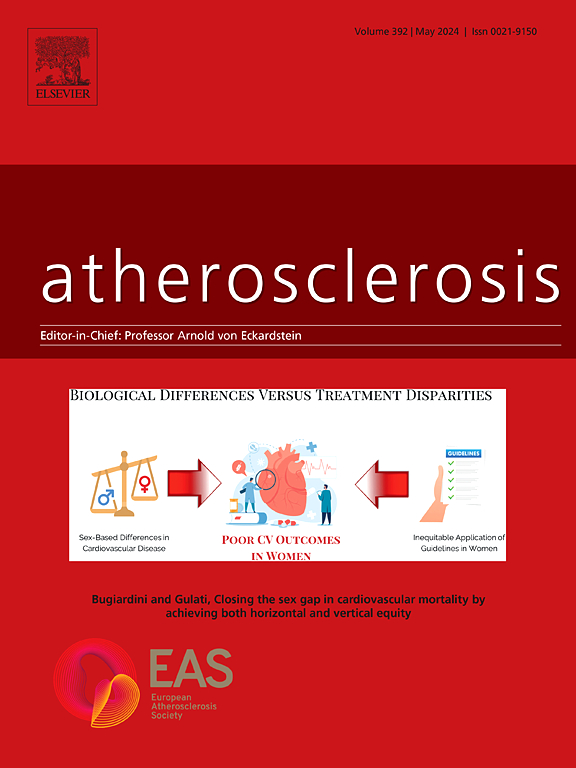在接受经皮冠状动脉介入治疗的患者中,不同高敏c反应蛋白切断点的全身性炎症的临床影响
IF 5.7
2区 医学
Q1 CARDIAC & CARDIOVASCULAR SYSTEMS
引用次数: 0
摘要
背景和目的全身性炎症可促进冠状动脉粥样硬化的进展,并可通过高敏c反应蛋白(hsCRP)进行评估。然而,在确定与心血管风险增加相关的最佳hsCRP阈值方面存在异质性。在这里,我们使用不同的hsCRP升高截止值来评估冠心病患者接受经皮冠状动脉介入治疗(PCI)时炎症的影响。方法回顾性分析2012年至2022年在美国纽约西奈山医院接受PCI治疗的患者。根据常用的基线hsCRP阈值对患者进行分层。主要终点是MACCE,定义为全因死亡率、心肌梗死或卒中的综合。结果在10811例患者中,6210例(57.4%)hsCRP为2mg /L, 1624例(15.0%)为2 ~ 3mg /L, 2977例(27.6%)为3mg /L。使用hsCRP = 3 mg/L (4.9% vs. 2.6%; p < 0.001)和hsCRP = 2 mg/L阈值(4.4% vs. 2.4%; p < 0.001)时,每组hsCRP升高的MACCE发生率均增加。hsCRP值在2 ~ 3 mg/L之间的患者发生MACCE的风险也更高(HR: 1.44, 95% CI 1.03 ~ 2.00; p = 0.032)。对于两个阈值,受试者工作特征(ROC)曲线显示出相似的预测MACCE的能力。结论:在接受PCI的患者中,hsCRP值高于既定阈值2和3mg /L预测1年MACCE的风险增加,但两种阈值在预测心血管风险方面都不具有优势。与低于2 mg/L的hsCRP患者相比,2 - 3mg /L的hsCRP患者的事件发生率增加。本文章由计算机程序翻译,如有差异,请以英文原文为准。

Clinical impact of systemic inflammation across different high-sensitivity C-reactive protein cutoffs in patients undergoing percutaneous coronary intervention
Background and aims
Systemic inflammation enhances coronary atherosclerosis progression and is assessed by high-sensitivity C-reactive protein (hsCRP). However, heterogeneity exists in defining the optimal hsCRP threshold associated with increased cardiovascular risk. Here we evaluated the impact of inflammation in patients with CAD undergoing percutaneous coronary intervention (PCI) using different cutoffs of hsCRP elevation.
Methods
We conducted a retrospective analysis of patients undergoing PCI from 2012 to 2022 at Mount Sinai Hospital (NY, USA). Patients were stratified according to commonly used thresholds of baseline hsCRP. The primary endpoint was MACCE, defined as the composite of all-cause mortality, myocardial infarction, or stroke.
Results
Of 10,811 patients included, 6210 (57.4 %) had hsCRP <2 mg/L, 1624 (15.0 %) between 2 and 3 mg/L, and 2977 (27.6 %) > 3 mg/L. Increased rates of MACCE were observed in each group with elevated hsCRP using both the hsCRP = 3 mg/L (4.9 % vs. 2.6 %; p < 0.001) and hsCRP = 2 mg/L thresholds (4.4 % vs. 2.4 %; p < 0.001). The risk of MACCE was also higher in patients with hsCRP values between 2 and 3 mg/L (HR: 1.44, 95 % CI 1.03–2.00; p = 0.032). For both thresholds, the receiver operating characteristic (ROC) curve showed similar ability to predict MACCE.
Conclusions
In patients undergoing PCI, hsCRP values above both established thresholds of 2 and 3 mg/L predict an increased risk of 1-year MACCE, but neither threshold was superior in predicting cardiovascular risk. Patients with hsCRP between 2 and 3 mg/L have increased event rates compared to patients with hsCRP below 2 mg/L.
求助全文
通过发布文献求助,成功后即可免费获取论文全文。
去求助
来源期刊

Atherosclerosis
医学-外周血管病
CiteScore
9.80
自引率
3.80%
发文量
1269
审稿时长
36 days
期刊介绍:
Atherosclerosis has an open access mirror journal Atherosclerosis: X, sharing the same aims and scope, editorial team, submission system and rigorous peer review.
Atherosclerosis brings together, from all sources, papers concerned with investigation on atherosclerosis, its risk factors and clinical manifestations. Atherosclerosis covers basic and translational, clinical and population research approaches to arterial and vascular biology and disease, as well as their risk factors including: disturbances of lipid and lipoprotein metabolism, diabetes and hypertension, thrombosis, and inflammation. The Editors are interested in original or review papers dealing with the pathogenesis, environmental, genetic and epigenetic basis, diagnosis or treatment of atherosclerosis and related diseases as well as their risk factors.
 求助内容:
求助内容: 应助结果提醒方式:
应助结果提醒方式:


